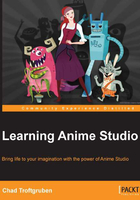
Understanding the basics of vector and raster graphics
Before we begin drawing in Anime Studio, it's important to understand the differences between vector and raster graphics. Anime Studio allows you to output both types of graphics, and each has its strengths and weaknesses.
Vector drawings are created whenever you use a drawing tool in Anime Studio. This is also the main format for Adobe Flash, Toon Boom, and Adobe Illustrator. Vector format is a popular choice and has been dominating the Internet cartoon scene for several years.
The following image is an example of a vector image. Notice how all the lines retain a sharp quality.

Vector graphics tend to have smaller file sizes compared to equivalent raster graphics. This not only makes streaming embedded Shockwave Flash (SWF) easier, but also keeps your project files lower in size, thus freeing up more space on your hard drive and cutting down on load times.
Raster or bitmap images are made up of pixels. Common file types include JPEG, BMP, PNG, and GIF. Basically, images you take with your camera, found on the Internet (at least the majority of them), or created in Adobe Photoshop are raster graphics. Raster graphics can be imported into Anime Studio and used for different functions. While they can contain great detail, raster graphics have many disadvantages when it comes to animation. As they are pixel-based, if you enlarge or zoom into a raster graphic past its original size, you will lose the image's quality. They also tend to bloat project file sizes up; this is due to the pixels needing more information to display the image.
Many artists do find raster images worthwhile; additionally, you have the ability to convert raster images into vector graphics if desired. This method is called tracing, and while it can be useful, it's definitely not 100 percent effective, especially when trying to make the image work with animation. The following image is an example of a raster graphic. Compare it to the previous vector image. Note how the raster graphic appears blurry or pixelated in comparison.

Now, you must be wondering which image type is the best. There is really no right or wrong answer to this question. It all comes down to personal preference and what you plan to do with your cartoon. We will explore a few uses of bitmap images in this book, but the primary focus will be on creating vector art through the drawing tools.